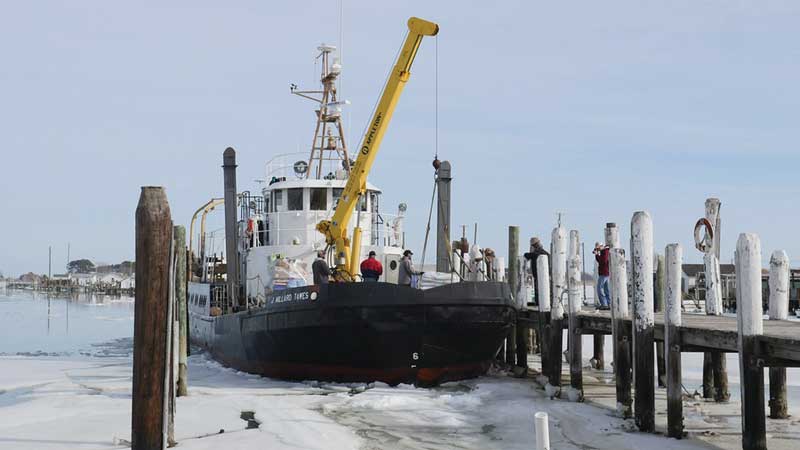Most boaters cringe at the thought of anything scraping against the hull of their boat, but when a 100-ton steel vessel cuts through ice, there’s no avoiding the noise that is generated. “What surprised me most when I first started breaking ice was the rumbling sound you hear,” says Lee Daniels, captain of the icebreaker J. Millard Tawes.

When cold weather settles upon the Chesapeake region, most boaters tuck their vessels away until spring, but those who work the water year-round count on the Bay’s icebreakers to clear a channel when the Bay’s tributaries freeze. Captains of commercial vessels, oystering and fishing boats, emergency vessels, and island ferries are just some of the vessels that depend on the Tawes, which sails out of Crisfield, MD.
“We never know exactly when we’ll be needed” says Daniels, “but when the water temperatures start to drop, beginning about mid-December until early March, we’re on call for icebreaking.” The vessel has a crew of four (captain, engineer, mate, and deckhand), and when it’s not clearing ice, it operates as a buoy tender.
“One of the best parts of the job is that we see a lot of nature out there,” says Daniels. “When the sun’s rising and no other boats are out, it is very peaceful and serene.”
The main icebreaking track for Tawes is between Crisfield Harbor and Smith Island, where it will clear a path for the school boat, which takes children to school on the mainland, and two other supply boats that carry mail, groceries, medication, and other necessities.
The Tawes also breaks up ice for watermen to get out for oystering, and when needed, will go up the Wicomico River to clear a track for the tugboats and barges carrying oil for heating fuel into Salisbury, MD.
“When it’s really bad,” says Daniels, “we may be called to go to Tangier Island, VA, to clear a channel for its supply boat.” The Tawes is capable of cutting through ice up to 18 inches thick, but the most ice they’ve seen in recent memory was about 15 inches in 2015.
“The winter of 2015 was exciting,” says Ozzie Wilkinson, who has worked as the engineer aboard Tawes since 2006. Wilkinson looks forward to the ice breaking season. “It’s something different from buoy tending, and it feels good to know we’re really helping people.” Wilkinson’s year-round responsibilities include maintaining the equipment and electrical and mechanical systems (the boat dates to 1942). When the crew is breaking ice, Wilkinson helps the captain steer the rear end in the close quarters of the harbors. When they are buoy tending, he operates the 10-ton crane on deck.
Wilkinson has been on the water his whole life. Prior to the Tawes, he worked on a Maryland Department of Natural Resources (DNR) research vessel, and before that he was an engineman in the U.S. Navy. “I’m 60 years old,” he says, “and this is the best job I’ve had. I love the opportunity to help people and to serve the State of Maryland.”
For more information on DNR Hydrographic Operations ice breaking (it has last year’s dates but is still valid information), visit: dnr.maryland.gov/boating/Pages/ice_breaking.aspx. To learn more about the other icebreakers on the Bay, click here.